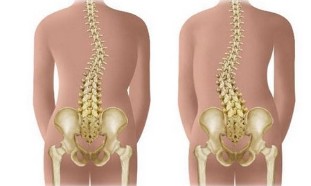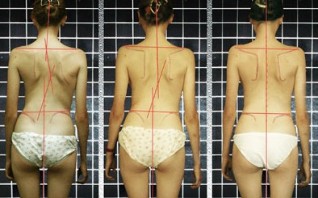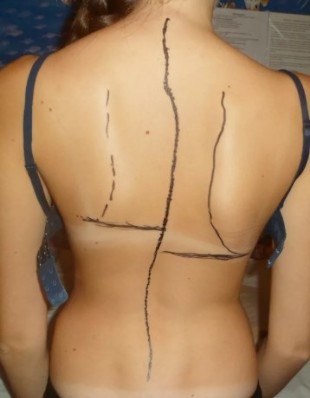In Greek, the word "scolios", which translates as "the curve". This word of doctors indicate a deviation of the spinal column. And this is not all in curvature, and it is the lateral deviation of the vertical axis of the spine. The fact that the rate of our spine is not perfectly smooth. Available at the front and the rear direction of the curves (lordosis and kyphosis) protect our spine from excessive loads during the time to maintain the body in a certain position of the movement and transportation of heavy loads. The negative processes in our body develops only in the cases, if these kyphosis and lordosis expressed beyond tolerable.

The main problems
However, even a small degree of lateral curves (scoliosis) of the spine is always pathology. And it is not only a cosmetic defect. Although the characteristic of an appearance when it is or progressive scoliosis is always a tragedy for the person seeking to live the quality of life. This applies in particular to the young girls and boys. In fact, it is in the childhood and youth of the period (15 – 16 years old) is diagnosed with a large part of the scoliosis.
The main problem lies in the fact that, due to changes of the configuration and the volume of the chest, when it is expressed on the side of the curvature always suffer the internal organs (heart, lungs, stomach, liver, intestines, major blood vessels). In men decreases the tolerance to physical effort, women experience difficulties in conceiving, bearing of pregnancy and childbirth. In addition, very often, the lateral deformation of the spine is only a part merge of the iceberg, which is a sign of much more serious pathology of the tumour, tuberculosis, endocrine disorders.
The reasons
Why, then, deforms the spine? Before responding to the question of determining the types of scoliosis. Intrinsically scoliosis can be structural and non-structural. Structural scoliosis develops because of the anatomical variations of the bone structure of the vertebrae, as well as the proximity of the muscles, the nerves, are, of the ligamentous apparatus. These curvature can be acquired or congenital, and where the share of the latter accounts for about a quarter of all diagnosed scoliosis.
Among the main reasons for the structural development of scoliosis include:

- The vices of gestation, leading to dysplastic violations of one or more vertebrae
- Congenital abnormalities of the thorax – the absence of ribs, the ribs
- Congenital connective tissue disorders – neurofibromatosis, Marfan syndrome
- Failure due to cerebral palsy (CP), leading to a violation of the innervation of certain areas of the spine
- Osteoporosis (loss of bone) of the spine in rickets, a disease of the parathyroid glands, the lack of revenue in calcium
- Osteomyelitis vertebrae
- Degenerative changes cervical, thoracic, and lumbar muscles
- Tb damage to the vertebrae
- Injuries of the spine
- The institute of the spine.
Non-structural scoliosis, as its name suggests, is a side of the axis of the spine at the unchanged the structure of the spine. As a general rule, these scoliosis most often purchased except in cases where the curvature of the door off within the malformations anatomic defects of the pelvis or the lower limbs. The causes of scoliosis most often are:
- Injuries of the pelvis and the lower limbs
- Congenital malformations of the pelvis and the lower limbs
- The constant poor posture in school children
- The diseases of the internal organs with pronounced slant syndrome
- Inflammation of muscles (myositis)
- Burns, scarring of the soft tissues with a single side.
In these cases, to correct the curvature of the spine in a enough to cure an underlying disease, and therefore a lot of non-structural scoliosis are easily reversible. In this regard, some doctors have a tendency to do not claim the non-structural deformity in scoliosis in general.

Recently, the case of development in young scoliosis of mysterious reasons. This is called idiopathic scoliosis. Occur in the teenage years, in a period of rapid growth of the organization. And girls suffer from idiopathic scoliosis is several times more often than boys. Apparently, this is due to the relative weakness of the muscles of the back in the female sex, which is not capable of entering into the spine part of the carcass. An important role in the development of idiopathic scoliosis plays an imbalance food that is low in calcium salts, the craze of youth soft drinks. As is well known, the carbon dioxide in the bubbles, and the phosphoric acid content in the composition of the inclusions synthetic contribute to the leaching of calcium salts from the body.
The type and degree of
Depending on the location of scoliosis can be the cervix, breast, lumbar or mixed (cervico-breast, sciatica, breast). Perhaps the presence of one or several arcs of curvature. In this regard, to distinguish With scoliosis (1 arc), S-u (with 2 bows), and Z-u (with 3 bows). Very probably, the presence of 2 or 3 arcs wears a character off. With scoliosis, the axis of the spine to the side. While trying to compensate for this, the spine will curve in the opposite direction. In this regard, the scoliosis share the offset and pascompensé. Of offset curves of the spine, a vertical line, dropped from the 7th cervical vertebra, crosses the crease between the buttocks.
The curvature of the spine are very often worn sochetanniy nature. For example, in the thoracic region, in addition to the curvature is celebrated pathological kyphosis, or simply the kicker. In these cases, speaking of is in kyphoscoliosis . In addition, large degrees of scoliosis, in addition to lateral displacement of the vertebral was whelks. Literally it means twist. In fact, in many of the scoliosis is bone twisting of one vertebra on the vertical axis.
Depending on the value of the angle of curvature of the arc secrete 4 degrees of scoliosis:
- 1 degree of angle of curvature not exceeding 10 degrees. The asymmetry on the eyes almost is not defined. Attracts the attention of soft, not the level of the shoulder girdle. jpg" class="imgblock right center_mob">
- 2 the degree of the angle of curvature is from 11 to 25 degrees. In this measure, already celebrated whelks vertebrae. There is visible to the eye the asymmetry of the shoulder girdle and pelvic. Because of the disease of the muscular tension formed muscle roller in the lumbar area with one hand, and in the region of the chest – convex.
- 3 degree – the deviation is 26 to 50 degrees. Visible deformation of the thorax – the retraction of spaces between ribs in the concave side of the curvature and the bulging convex. The weakening of abdominal muscles, the internal training of hunchback.
- 4 the degree of the angle of the curvature, I is greater than 50 degrees. Expressed cosmetic defects and all of the symptoms. Low portability, even small physical exercise. In addition to the musculoskeletal disorders affecting the internal organs.
The angle may vary as a function of the position of the body, secrete stable and unstable scoliosis. If unstable scoliosis, it decreases in a lying position, when one decreases the load on the spine. When the permanent curvature of the spinal column, that value remains unchanged.
The symptoms
Recently, orthopedic surgeons often use the term "scoliosis disease". And indicate the services of the negative changes that occur in the body of a curvature of the spine. Generally, the scoliosis, the disease develops in childhood and adolescence, a period of training musculoskeletal. In this moment, you have a greater likelihood that the scoliosis will progress.
Apparently, an important role in the increase of the angle of the curvature to play the intervertebral discs. During the lateral movement of the disk is experimenting with the variability of the pressures on the part of the vertebral bodies. With a share of this pressure is more convex less. The result of this drive even more wear and tear on the part of the scoliosis, is created pathological muscle tension (the muscles on the roll) and whelks vertebrae – all of this led to the emergence of the herniated discs and a further increase of the angle of the curvature.

Parallel to the spine when scoliosis illness secondary changes of the thoracic cage. Formed a so-called form of kicker – with the convex side of the curvature costal spaces dilate and concave in the opposite, flow. When the scoliosis 4 the degree of deformation of the thoracic cage is so pronounced that the lower ribs on the side of the curvature in contact with the crest of the iliac bone.
In reason expressed by the deformation of the chest full of the visit when the breathing is difficult. Finally the body when it is expressed the scoliosis does not receive the necessary amount of oxygen, develops so-called chronic hypoxia with the violation of all metabolic processes in the body. The pathology is further aggravated by the fact that changes in the interior volume and the shape of the thoracic cavity. Because of this disrupted the flow of the blood through the vessels, suffer the lungs, the changes of the shape of the heart, develops chronic cardio-respiratory system.
Similar changes occur in the organs of the abdominal cavity in the lumbar and lumbosacral the scoliosis. Decline of motor function of the stomach and intestine follow-enzymatic insufficiency of digestive glands. All of this only exacerbates the metabolic. These disorders are often late to the sexual maturation of boys and girls. In addition, because of the lumbar scoliosis secondary bypasses the basin. This creates problems for moms-to-be with the bearing of pregnancy and childbirth.
The diagnosis
The diagnosis of scoliosis, especially big degrees, generally, does not present any difficulty. For the detection of the deformation of the spine is often quite normal to visual inspection. Remarkable visible the contours of the curvature of the spine, asymmetry of the shoulder girdle, the angles of the vanes for the secondary curvature of the pelvic region and the shortening of the lower limb on the side of the curvature.
If at least one of these signs shows an x-ray of the spine. On the x-rays define the configuration, the degree and location of curves. In the course of inspection and x-ray examination, you can determine if the scoliosis is compensated and stable. Recently, it has been distributed, a new method of study of the spine – magnetic resonance imaging (MRI), during which the display on the monitor, you can obtain a three-dimensional image of the spine. When significant curvature you need to review the functioning of the internal organs – pass the spirometry, using the ecg, to perform an ULTRASOUND of the heart and internal organs.
Treatment
The treatment of scoliosis can be performed as a curator, and quickly. The conservative methods ominous addiction treatment, massage, physiotherapy, chiropractic. It should be noted that the formation of the final of the spine ends at the age of 20 years, and after age correction of the curvature is practically impossible. When the scoliosis of 1 to 2 degrees of efforts are aimed at achieving of origin, the configuration of the spine. When it is expressed the scoliosis 3 – 4 degree this is impracticable, the point here is to stabilize the spine and prevent the progression of scoliosis.

Drugs (chondroprotectors, vitamins, restorative, drugs) in the treatment of scoliosis play a secondary role. Strengthen muscles, eliminate muscle roller, and even to a large extent to stabilize the spine using massage and manual therapy. A good effect to give sessions of physiotherapy. But here, in the inadequate, the physical activity is reinforced by the instability of the spine and progression of the scoliosis. Therefore, the set of exercises designed for each patient taking into account the location and severity of the curvature. The great extent of the scoliosis is against the run, strength exercises, jumps, outdoor games.
A very good result gives a correction of the situation created in optimal posture, which contributes to the normalization of the posture. For this, orthopedic appliances, beds in which young people spend a large part of his time. The ineffectiveness of conservative measures, the progression of the curve shows a surgical treatment aimed at stabilization of the spine. The surgical correction is not indicated in the early childhood, their transition to adulthood, when the formation of the vertebral column is nearly complete.





























